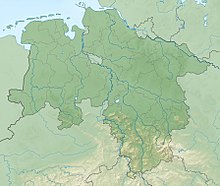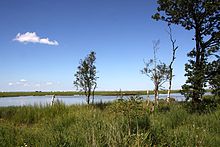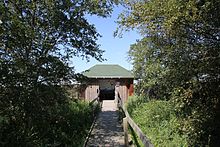Floating moor
Coordinates: 53 ° 26 ′ 29 ″ N , 8 ° 18 ′ 10 ″ E
The floating moor or Sehestedter outer dike moor is a unique natural monument located on the Jade Bay in the Jade municipality ( Wesermarsch district ) near the Sehestedt district. The bog is the only outer dike bog in the world and is counted among the flood bogs today. Since 1986 it has been part of the Lower Saxony Wadden Sea National Park . Before it was part of the “Jade Bay Bird Sanctuary” (WE 87) under nature protection .
Originally this moor was inland, separated from the sea by marshland . It developed from a low moor to a high moor . The underside of the peat moss lay deeper than the surface of the upstream coastal marsh, its surface higher. Before the sea dykes were built in the 12th century, storm surges could penetrate the moor. With the advance of the Jade Bay, the seashore reached the moor. During storm surges, the moor and the houses built on it were raised from the water. Sometimes considerable areas of moorland were torn down and driven away, and when the floods started, they were deposited again at a considerable distance. Large areas of moorland were lost on the area of today's Jade Bay and the Lockfleth that existed in the 14th and 15th centuries. The former moor areas were also referred to as Hoben , originally the Frisian word for floating moor.
While people, animals and even buildings (as far as they were not bricked up ) often survived floating up without any problems , there was a high risk of flooding for the adjacent marshland; If the dyke was allowed to end at the edge of the moor, the ends of the dyke would be washed away, and dykes built into the moor have little strength. In the 16th century the unspoiled moor had an area of 135 hectares. In 1725 the last gap between the villages of Schweiburg and Seefeld was closed. Land losses in this area have only been very small since the beginning of the 19th century. However, the dike built through the moor continues to cause static problems. In 1958, for example, the dike sagged by 1.50 meters due to a break in the boggy subsoil. The dike was raised to the old level with new clay. The dike was raised in 1984 with a steel sheet pile wall (dike height 8.60 meters) in order not to endanger the floating moor, which is unique in the world. Since 2011, sheet pile walls up to 25 meters deep have ensured the stability of the dike.
Since the dike was closed in 1725, part of the moor has been outside the dike and continues to be raised and " floated" during storm surges with heights of 3.25 m above sea level (that is 2.50 m above mean flood). Everything on the moor surface remains intact (trees, freshwater couloirs or wells). The last house on the outside of the dyke existed until 1908 and survived the storm surge of 1906 in this way. Floating up (opening the entire moor area before the dike was created) used to give its residents sufficient security against storm surges. Therefore, there was no dike in the area of the floating moor for a long time.
Due to the demolition of the moor edges, the floating moor shrank to 10 hectares. Only a small part of the foreland of the dike, a strip immediately west of the sea dike, consists of the floating moor; the greater part of the dike foreland near Sehestedt today is formed by salt marshes .
In 2007 a boardwalk and an observation station for visitors were built in the moor .
literature
- Karl-Ernst Behre : The moor of Sehestedt (= Oldenburg research. Volume 21). Wachholtz Verlag , Neumünster 2008
Web links
- Floating moor near Sehestedt at NordwestReisemagazin.de
- Floating moor in the culture portal Northwest
Individual evidence
- ↑ a b The floating moor in Sehestedt. Friesländer Bote, May 20, 2005 ( Memento from February 8, 2013 in the web archive archive.today ).
- ^ Oskar Tenge: The Butjadinger Deichband. Section D: The dike in the Vogteien Schwei and Jade and in the Amte Varel 1613 to 1617. Schulzesche Verlagsbh. R. Schwartz, Oldenburg 1912.
-
↑
Comparison of the coastlines:
- 1805: Karl Ludwig von Le Coq : Topographical map in XXII sheets containing the largest part of Westphalia ... Published by General Major von Le Coq in 1805 (actually 1805 - 1814): Section IV: Duchy of Oldenburg ...
- 1898: Map archive of the University of Greifswald , measuring table sheets: 2515 Jadebusen (1898) ( Memento of the original from March 4, 2016 in the Internet Archive ) Info: The archive link was inserted automatically and has not yet been checked. Please check the original and archive link according to the instructions and then remove this notice. .
- ^ Arnold Meyer: Floating moor near Sehestedt. NordwestReisemagazin.de, accessed on May 27, 2012.
- ↑ Elevation of the dike "Floating Moor" near Sehestedt. Website of the planning office Eriksen Oldenburg, accessed on December 29, 2017.
- ↑ The outer dike moor of Sehestedt on the east side of the Jadebusen: "Floating Moor" nature reserve (PDF; 1.2 MB). In: Geographical Commission for Westphalia: Festschrift 40 years GKW. Münster 1977, p. 417f.


